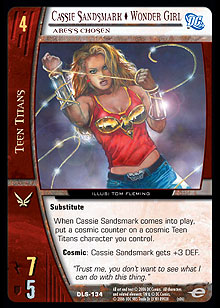Basics 5.3: The Mechanics
Previous Basics articles
· Basics Part 1: First Steps
· Basics Part 2: Off Curve
· Basics Part 3: Playing the Game
· Basics Part 4: Know Your History
· Basics Part 5.1: The Mechanics
· Basics Part 5.2: The Mechanics
· Basics Part 6: Organized Play
· Basics Part 7: The Art of Tech
· Basics Part 8: Gadgets
Last year, I put together a short series of articles that were aimed at helping the new Vs. System player become comfortable with all aspects of the game. Today, I want to revisit the Mechanics section. Since I wrote the last piece covering some of the game’s keywords, we’ve seen two new sets hit the shelves: Legion of Super Heroes and Marvel Team-Up. Both sets brought us some interesting new mechanics to play with, so it’s about time we had a look at them.
 Substitute
Substitute
This mechanic appeared in the last release of 2006, Legion of Super Heroes, and it caused quite a stir.
Substitute endows a character with the following payment power:
Reveal this card >>> You may remove from the game a ready character you control with cost greater than or equal to the cost of this card. If you do, put this card into play. Use this power only if this card is in your hand and only during your recruit step.
Now that’s a pretty nifty ability, if you ask me. Being able to change your board in response to a changing situation is very powerful, but before we go into some of the scenarios and situations that might arise, it’s important that you get your head around the fact that the uniqueness rule does apply to substituted characters. Although the wording of the power states that you “put the card into play” and that mechanism normally circumnavigates the uniqueness rule, UDE has stated in the official FAQ that “Substituting a character into play invokes the uniqueness rule, just like recruiting a character.”
The other important point to be clear about is when you can substitute. As the FAQ states, you can only substitute during your recruit step. I’ve heard many people getting confused over this. There is, to date, one card that allows substitution outside of the recruit step: Raven, Rachel Roth. The main benefit of substitution comes from understanding the matchup you’re in. For example, if you’re playing with a Teen Titans deck against a New Brotherhood deck and it’s your opponent’s turn 5 initiative, you might want to substitute out your Bart Allen ◊ Kid Flash, Heir to the Mantle in favor of the more defensively minded Bette Kane ◊ Batwoman, Titans Tomorrow East.
If you’re planning to utilize a theme of substitution, you must make allowances for hand disadvantage. Remember that you are going to be recruiting a character as well as substituting someone in. The replaced character is removed from the game, so there will be no recursion from the KO’d pile. Once your character has been subbed out, it’s out of the game for good. With this in mind, some extra card drawing seems to be necessary for maintaining any kind of hand size.
One thing that really interests me about substitution is the potential to kit your deck out with a lot of toolbox characters—ones that have the potential to turn around a particular matchup almost single-handedly. Substitution allows you to play that tech character without sacrificing any of your deck’s normal operating capacity.
 Alternate Boost
Alternate Boost
Now this is something I was very pleased to see in the latest Marvel expansion. Marvel Team-Up has introduced cards that have alternative methods with which to pay for a boosted recruit. To be perfectly honest, I have never been particularly fond of spending extra resource points on boost payments that trigger abilities that generally only last for one turn. I would much rather recruit a 7-drop than a 6-drop that pretends to be a 7-drop for just one turn.
Each card has a different cost that must be met for the boost power to trigger. For example:
Venom, The Hunger
“Boost–KO a Sinister Syndicate character you control: When Venom enters play, he gets +3 ATK / +3 DEF this turn.”
For Venom to trigger the +3 ATK / +3 DEF part of his power, you must KO a Sinister Syndicate character as Venom comes into play.
I’m positive that these new alternate boosts will be a lot more popular than the original incarnation of the ability. As a side note, how cool would this ability be in a team-up with the X-Statix!
 Pay ATK / DEF
Pay ATK / DEF
This is perhaps the most intriguing mechanic of all for me. The prospect of paying for powers with your combat stats is a really interesting new direction. Unlike resource points or endurance, it is very simple to generate new currency to spend on the new powers.
Once thing to be absolutely clear about before we continue is that if a character says “Pay X ATK,” that means that you reduce that character’s ATK by X until the end of the turn. You cannot pay ATK or DEF that you do not have, so if you control Dr. Octopus, Master of Evil and you want to use his power to stun a character with 13 DEF, you are going to have to increase Dr. Octopus’s ATK by 1. Dr. Octopus has to be attacking for the power to work, but other characters are not so restricted. With this in mind, you should make sure that you are using turn-length combat pumps that can alter your ATK before you’re actually within your attack step, or perhaps find ways to enhance your character’s stats:
If you have Dr. Octopus, Master of Evil protecting Thor, God of Thunder who is in turn adjacent to Spider-Man, Stark’s Protege, then you are set for complete domination of the opposition’s board (assuming the requisite Team-Up). There are so many ways to enhance ATK in this game that you will have plenty of opportunities to use these payment powers and still pose an offensive threat with your character.